Impact of Rewards on Employee Job Satisfaction at Hilton Hotel UK
VerifiedAdded on 2020/07/23
|50
|14708
|328
Report
AI Summary
This report analyzes employee job satisfaction and motivation within the Hilton Hotel in the United Kingdom, focusing on the impact of financial and non-financial rewards. The research employs interviews with both employees and managers to assess the significance of these rewards and their influence on employee performance. The report explores various reward systems and their effects on organizational growth and employee development. It investigates the crucial role of motivation in the hospitality industry, particularly in controlling employee turnover and enhancing service quality. The study aims to understand the factors that motivate employees, considering the diverse needs of the workforce and the importance of aligning reward strategies with employee expectations. The research concludes that analyzing the positive influence of financial and non-financial rewards is essential before implementing them to foster employee satisfaction and drive organizational success. The report also highlights the importance of employee motivation within the hospitality sector as a critical factor in controlling the turnover rate and thus preventing financial losses and degradation of service quality.
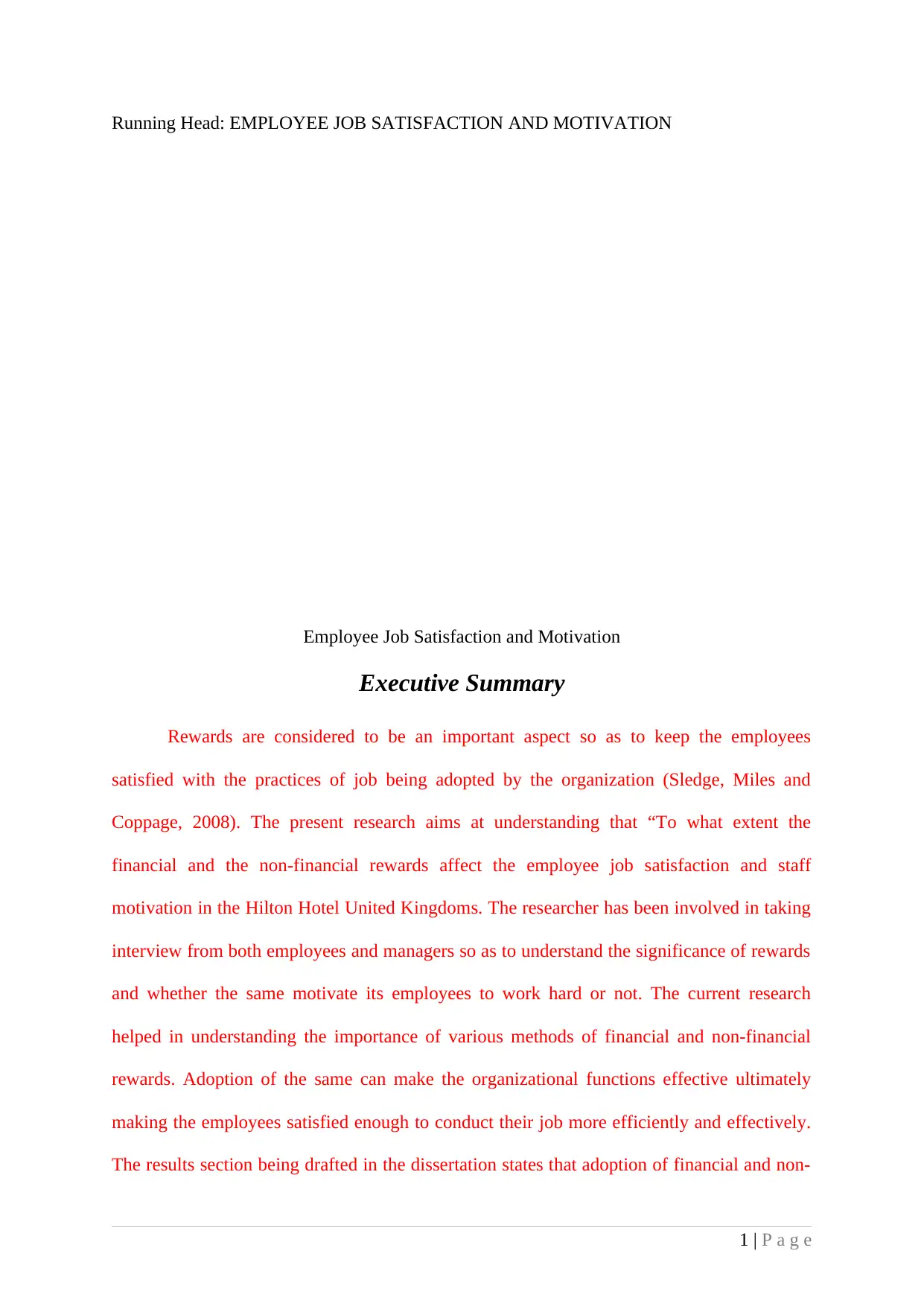
Running Head: EMPLOYEE JOB SATISFACTION AND MOTIVATION
Employee Job Satisfaction and Motivation
Executive Summary
Rewards are considered to be an important aspect so as to keep the employees
satisfied with the practices of job being adopted by the organization (Sledge, Miles and
Coppage, 2008). The present research aims at understanding that “To what extent the
financial and the non-financial rewards affect the employee job satisfaction and staff
motivation in the Hilton Hotel United Kingdoms. The researcher has been involved in taking
interview from both employees and managers so as to understand the significance of rewards
and whether the same motivate its employees to work hard or not. The current research
helped in understanding the importance of various methods of financial and non-financial
rewards. Adoption of the same can make the organizational functions effective ultimately
making the employees satisfied enough to conduct their job more efficiently and effectively.
The results section being drafted in the dissertation states that adoption of financial and non-
1 | P a g e
Employee Job Satisfaction and Motivation
Executive Summary
Rewards are considered to be an important aspect so as to keep the employees
satisfied with the practices of job being adopted by the organization (Sledge, Miles and
Coppage, 2008). The present research aims at understanding that “To what extent the
financial and the non-financial rewards affect the employee job satisfaction and staff
motivation in the Hilton Hotel United Kingdoms. The researcher has been involved in taking
interview from both employees and managers so as to understand the significance of rewards
and whether the same motivate its employees to work hard or not. The current research
helped in understanding the importance of various methods of financial and non-financial
rewards. Adoption of the same can make the organizational functions effective ultimately
making the employees satisfied enough to conduct their job more efficiently and effectively.
The results section being drafted in the dissertation states that adoption of financial and non-
1 | P a g e
Paraphrase This Document
Need a fresh take? Get an instant paraphrase of this document with our AI Paraphraser
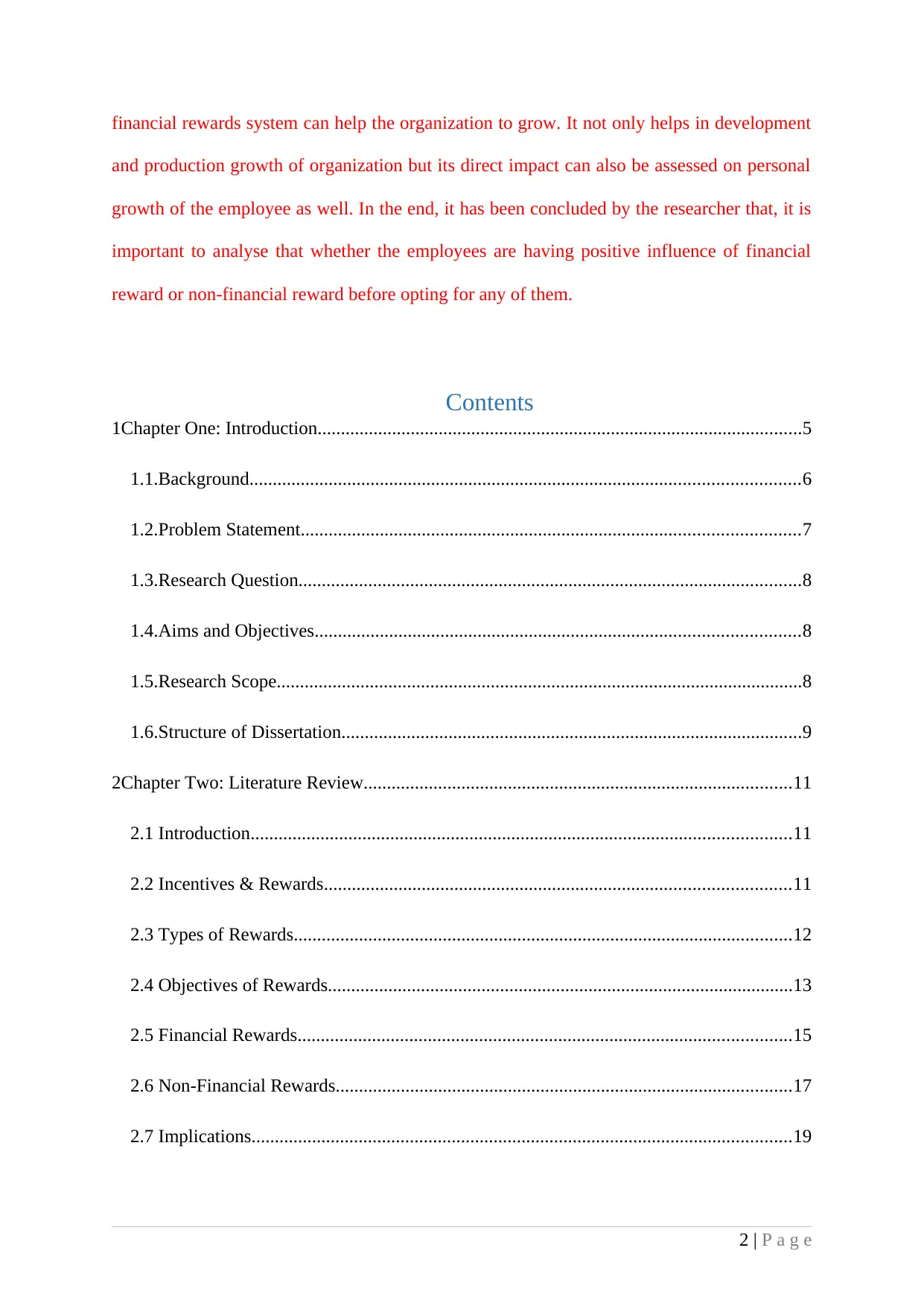
financial rewards system can help the organization to grow. It not only helps in development
and production growth of organization but its direct impact can also be assessed on personal
growth of the employee as well. In the end, it has been concluded by the researcher that, it is
important to analyse that whether the employees are having positive influence of financial
reward or non-financial reward before opting for any of them.
Contents
1Chapter One: Introduction........................................................................................................5
1.1.Background......................................................................................................................6
1.2.Problem Statement...........................................................................................................7
1.3.Research Question............................................................................................................8
1.4.Aims and Objectives........................................................................................................8
1.5.Research Scope.................................................................................................................8
1.6.Structure of Dissertation...................................................................................................9
2Chapter Two: Literature Review............................................................................................11
2.1 Introduction....................................................................................................................11
2.2 Incentives & Rewards....................................................................................................11
2.3 Types of Rewards...........................................................................................................12
2.4 Objectives of Rewards....................................................................................................13
2.5 Financial Rewards..........................................................................................................15
2.6 Non-Financial Rewards..................................................................................................17
2.7 Implications....................................................................................................................19
2 | P a g e
and production growth of organization but its direct impact can also be assessed on personal
growth of the employee as well. In the end, it has been concluded by the researcher that, it is
important to analyse that whether the employees are having positive influence of financial
reward or non-financial reward before opting for any of them.
Contents
1Chapter One: Introduction........................................................................................................5
1.1.Background......................................................................................................................6
1.2.Problem Statement...........................................................................................................7
1.3.Research Question............................................................................................................8
1.4.Aims and Objectives........................................................................................................8
1.5.Research Scope.................................................................................................................8
1.6.Structure of Dissertation...................................................................................................9
2Chapter Two: Literature Review............................................................................................11
2.1 Introduction....................................................................................................................11
2.2 Incentives & Rewards....................................................................................................11
2.3 Types of Rewards...........................................................................................................12
2.4 Objectives of Rewards....................................................................................................13
2.5 Financial Rewards..........................................................................................................15
2.6 Non-Financial Rewards..................................................................................................17
2.7 Implications....................................................................................................................19
2 | P a g e
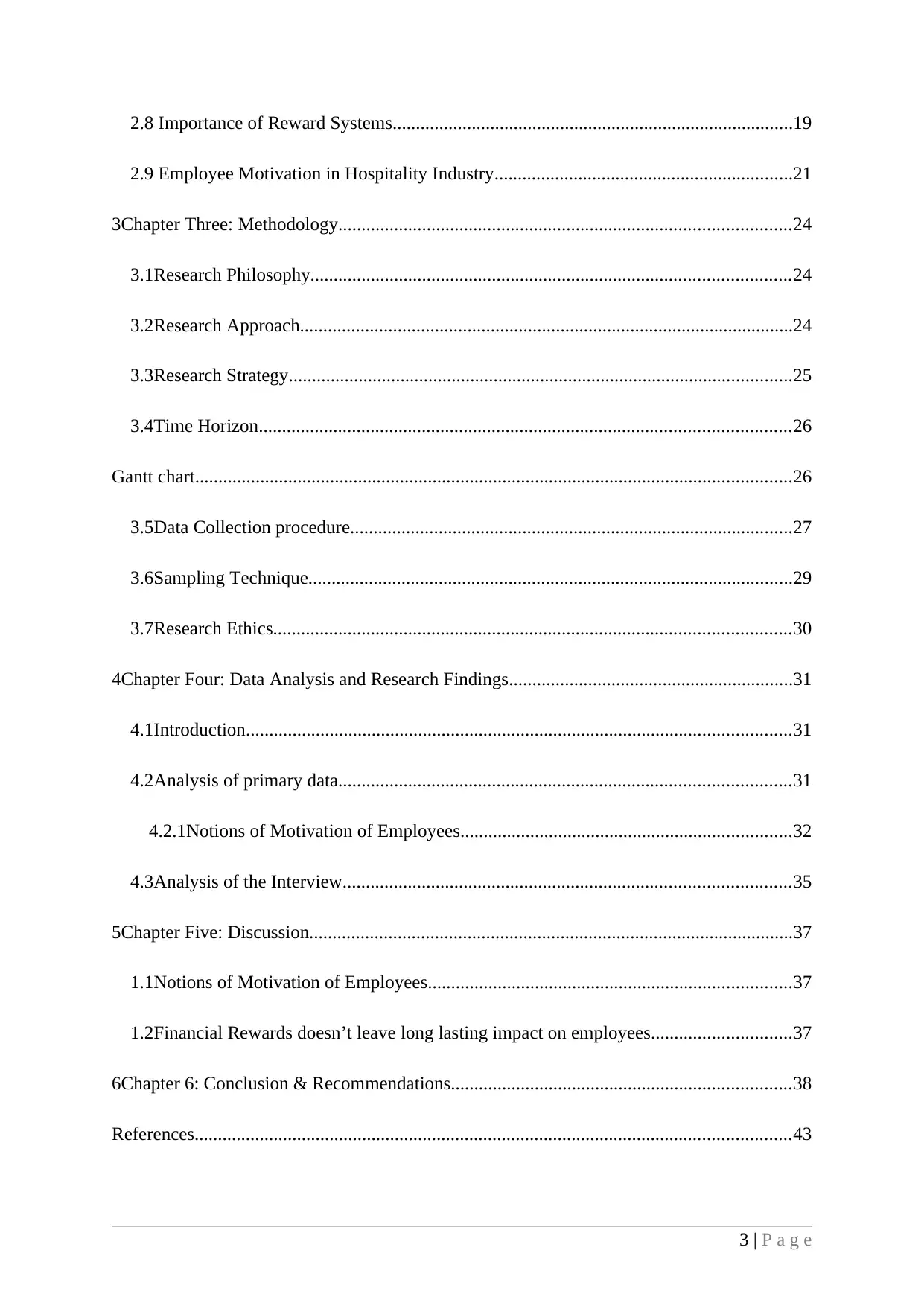
2.8 Importance of Reward Systems......................................................................................19
2.9 Employee Motivation in Hospitality Industry................................................................21
3Chapter Three: Methodology.................................................................................................24
3.1Research Philosophy.......................................................................................................24
3.2Research Approach..........................................................................................................24
3.3Research Strategy............................................................................................................25
3.4Time Horizon..................................................................................................................26
Gantt chart................................................................................................................................26
3.5Data Collection procedure...............................................................................................27
3.6Sampling Technique........................................................................................................29
3.7Research Ethics...............................................................................................................30
4Chapter Four: Data Analysis and Research Findings.............................................................31
4.1Introduction.....................................................................................................................31
4.2Analysis of primary data.................................................................................................31
4.2.1Notions of Motivation of Employees.......................................................................32
4.3Analysis of the Interview................................................................................................35
5Chapter Five: Discussion........................................................................................................37
1.1Notions of Motivation of Employees..............................................................................37
1.2Financial Rewards doesn’t leave long lasting impact on employees..............................37
6Chapter 6: Conclusion & Recommendations.........................................................................38
References................................................................................................................................43
3 | P a g e
2.9 Employee Motivation in Hospitality Industry................................................................21
3Chapter Three: Methodology.................................................................................................24
3.1Research Philosophy.......................................................................................................24
3.2Research Approach..........................................................................................................24
3.3Research Strategy............................................................................................................25
3.4Time Horizon..................................................................................................................26
Gantt chart................................................................................................................................26
3.5Data Collection procedure...............................................................................................27
3.6Sampling Technique........................................................................................................29
3.7Research Ethics...............................................................................................................30
4Chapter Four: Data Analysis and Research Findings.............................................................31
4.1Introduction.....................................................................................................................31
4.2Analysis of primary data.................................................................................................31
4.2.1Notions of Motivation of Employees.......................................................................32
4.3Analysis of the Interview................................................................................................35
5Chapter Five: Discussion........................................................................................................37
1.1Notions of Motivation of Employees..............................................................................37
1.2Financial Rewards doesn’t leave long lasting impact on employees..............................37
6Chapter 6: Conclusion & Recommendations.........................................................................38
References................................................................................................................................43
3 | P a g e
⊘ This is a preview!⊘
Do you want full access?
Subscribe today to unlock all pages.

Trusted by 1+ million students worldwide
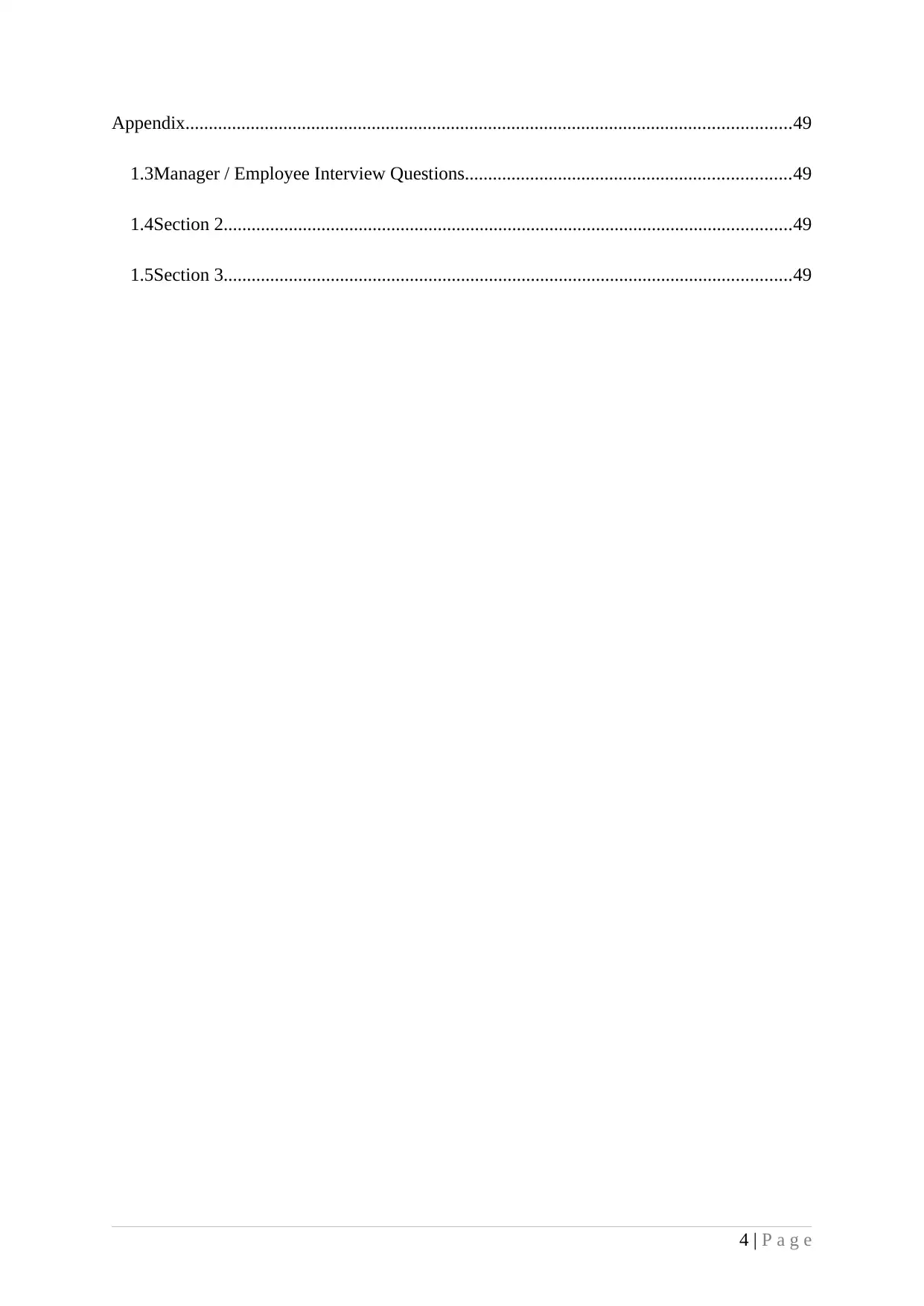
Appendix..................................................................................................................................49
1.3Manager / Employee Interview Questions......................................................................49
1.4Section 2..........................................................................................................................49
1.5Section 3..........................................................................................................................49
4 | P a g e
1.3Manager / Employee Interview Questions......................................................................49
1.4Section 2..........................................................................................................................49
1.5Section 3..........................................................................................................................49
4 | P a g e
Paraphrase This Document
Need a fresh take? Get an instant paraphrase of this document with our AI Paraphraser
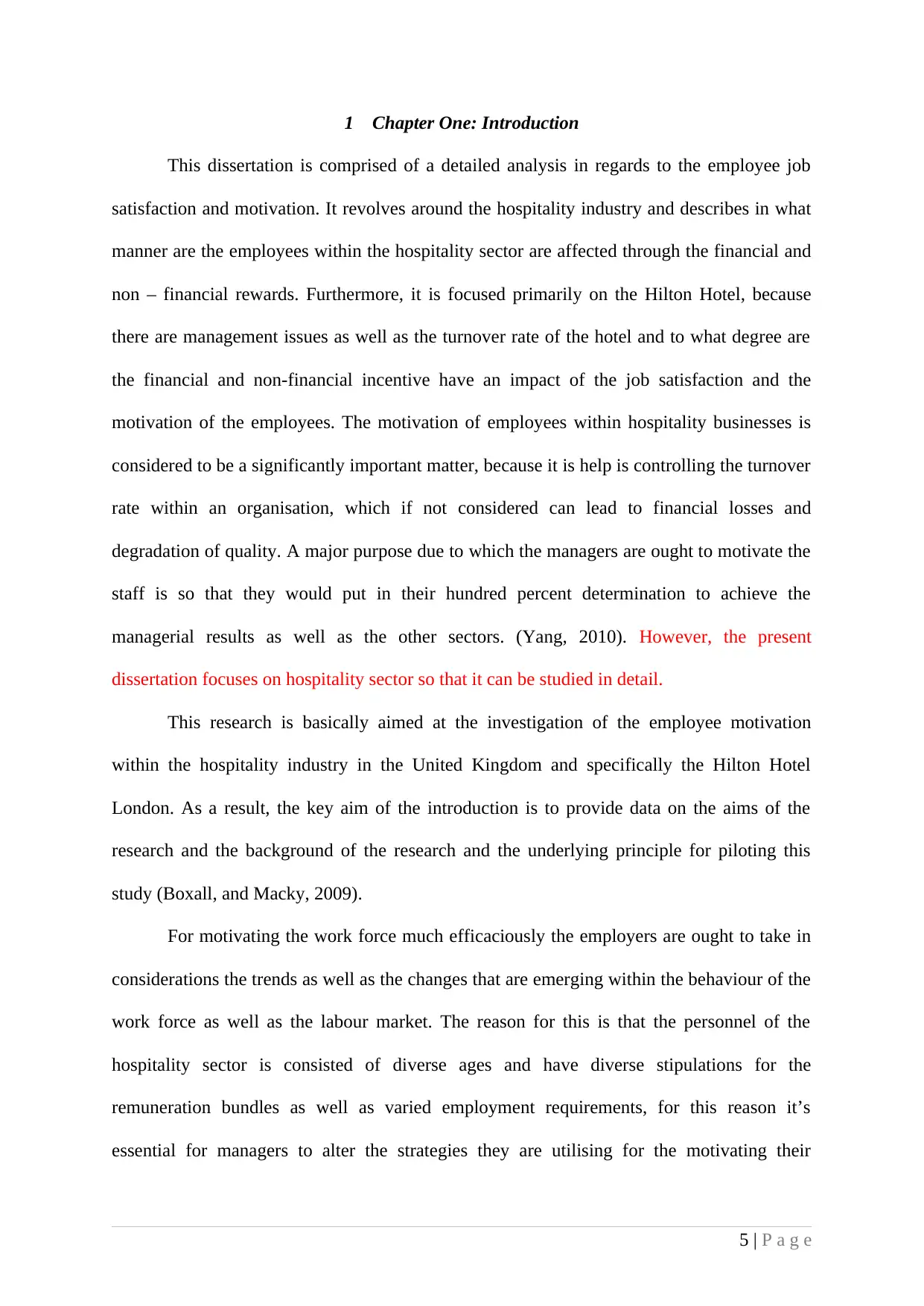
1 Chapter One: Introduction
This dissertation is comprised of a detailed analysis in regards to the employee job
satisfaction and motivation. It revolves around the hospitality industry and describes in what
manner are the employees within the hospitality sector are affected through the financial and
non – financial rewards. Furthermore, it is focused primarily on the Hilton Hotel, because
there are management issues as well as the turnover rate of the hotel and to what degree are
the financial and non-financial incentive have an impact of the job satisfaction and the
motivation of the employees. The motivation of employees within hospitality businesses is
considered to be a significantly important matter, because it is help is controlling the turnover
rate within an organisation, which if not considered can lead to financial losses and
degradation of quality. A major purpose due to which the managers are ought to motivate the
staff is so that they would put in their hundred percent determination to achieve the
managerial results as well as the other sectors. (Yang, 2010). However, the present
dissertation focuses on hospitality sector so that it can be studied in detail.
This research is basically aimed at the investigation of the employee motivation
within the hospitality industry in the United Kingdom and specifically the Hilton Hotel
London. As a result, the key aim of the introduction is to provide data on the aims of the
research and the background of the research and the underlying principle for piloting this
study (Boxall, and Macky, 2009).
For motivating the work force much efficaciously the employers are ought to take in
considerations the trends as well as the changes that are emerging within the behaviour of the
work force as well as the labour market. The reason for this is that the personnel of the
hospitality sector is consisted of diverse ages and have diverse stipulations for the
remuneration bundles as well as varied employment requirements, for this reason it’s
essential for managers to alter the strategies they are utilising for the motivating their
5 | P a g e
This dissertation is comprised of a detailed analysis in regards to the employee job
satisfaction and motivation. It revolves around the hospitality industry and describes in what
manner are the employees within the hospitality sector are affected through the financial and
non – financial rewards. Furthermore, it is focused primarily on the Hilton Hotel, because
there are management issues as well as the turnover rate of the hotel and to what degree are
the financial and non-financial incentive have an impact of the job satisfaction and the
motivation of the employees. The motivation of employees within hospitality businesses is
considered to be a significantly important matter, because it is help is controlling the turnover
rate within an organisation, which if not considered can lead to financial losses and
degradation of quality. A major purpose due to which the managers are ought to motivate the
staff is so that they would put in their hundred percent determination to achieve the
managerial results as well as the other sectors. (Yang, 2010). However, the present
dissertation focuses on hospitality sector so that it can be studied in detail.
This research is basically aimed at the investigation of the employee motivation
within the hospitality industry in the United Kingdom and specifically the Hilton Hotel
London. As a result, the key aim of the introduction is to provide data on the aims of the
research and the background of the research and the underlying principle for piloting this
study (Boxall, and Macky, 2009).
For motivating the work force much efficaciously the employers are ought to take in
considerations the trends as well as the changes that are emerging within the behaviour of the
work force as well as the labour market. The reason for this is that the personnel of the
hospitality sector is consisted of diverse ages and have diverse stipulations for the
remuneration bundles as well as varied employment requirements, for this reason it’s
essential for managers to alter the strategies they are utilising for the motivating their
5 | P a g e
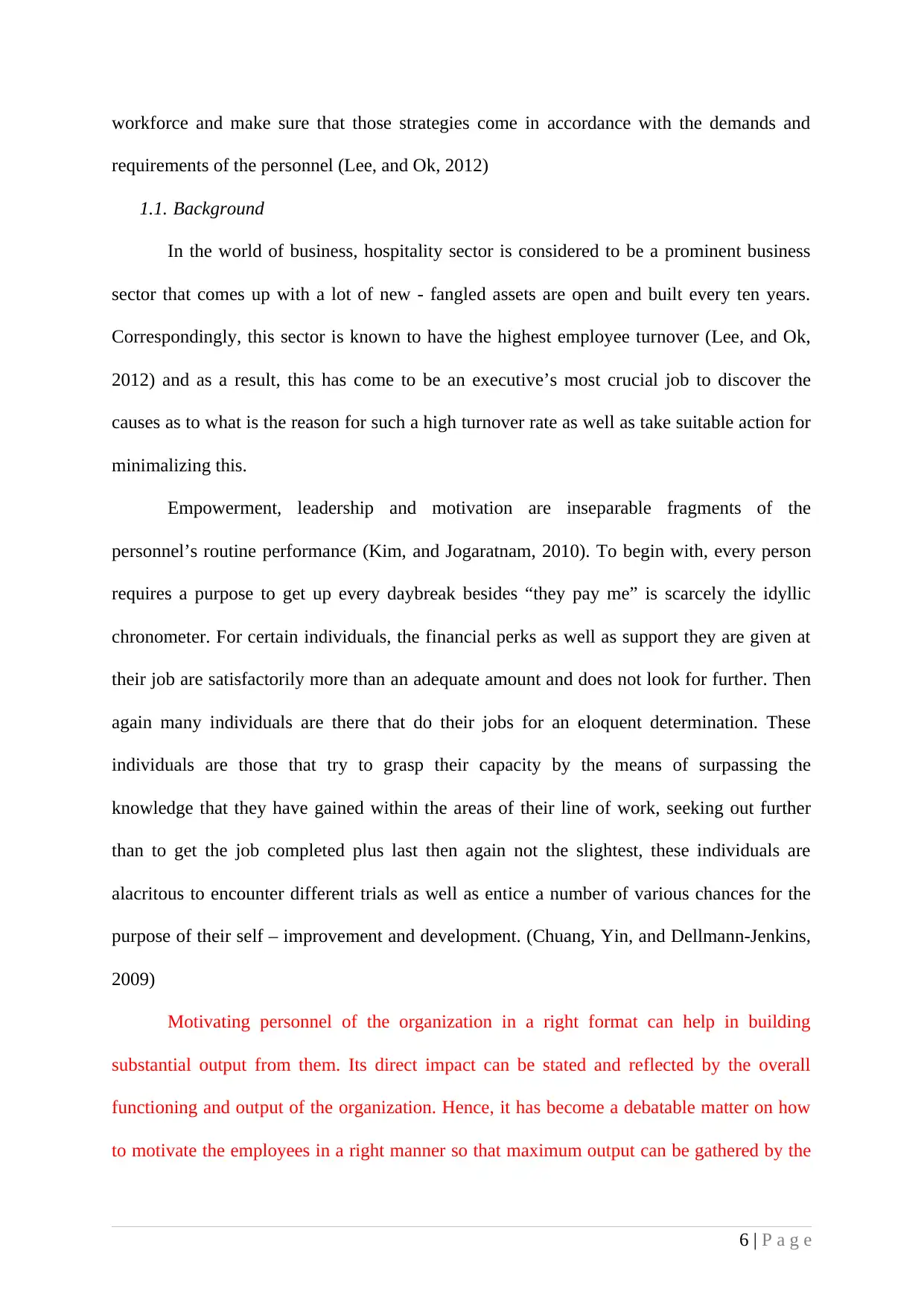
workforce and make sure that those strategies come in accordance with the demands and
requirements of the personnel (Lee, and Ok, 2012)
1.1. Background
In the world of business, hospitality sector is considered to be a prominent business
sector that comes up with a lot of new - fangled assets are open and built every ten years.
Correspondingly, this sector is known to have the highest employee turnover (Lee, and Ok,
2012) and as a result, this has come to be an executive’s most crucial job to discover the
causes as to what is the reason for such a high turnover rate as well as take suitable action for
minimalizing this.
Empowerment, leadership and motivation are inseparable fragments of the
personnel’s routine performance (Kim, and Jogaratnam, 2010). To begin with, every person
requires a purpose to get up every daybreak besides “they pay me” is scarcely the idyllic
chronometer. For certain individuals, the financial perks as well as support they are given at
their job are satisfactorily more than an adequate amount and does not look for further. Then
again many individuals are there that do their jobs for an eloquent determination. These
individuals are those that try to grasp their capacity by the means of surpassing the
knowledge that they have gained within the areas of their line of work, seeking out further
than to get the job completed plus last then again not the slightest, these individuals are
alacritous to encounter different trials as well as entice a number of various chances for the
purpose of their self – improvement and development. (Chuang, Yin, and Dellmann-Jenkins,
2009)
Motivating personnel of the organization in a right format can help in building
substantial output from them. Its direct impact can be stated and reflected by the overall
functioning and output of the organization. Hence, it has become a debatable matter on how
to motivate the employees in a right manner so that maximum output can be gathered by the
6 | P a g e
requirements of the personnel (Lee, and Ok, 2012)
1.1. Background
In the world of business, hospitality sector is considered to be a prominent business
sector that comes up with a lot of new - fangled assets are open and built every ten years.
Correspondingly, this sector is known to have the highest employee turnover (Lee, and Ok,
2012) and as a result, this has come to be an executive’s most crucial job to discover the
causes as to what is the reason for such a high turnover rate as well as take suitable action for
minimalizing this.
Empowerment, leadership and motivation are inseparable fragments of the
personnel’s routine performance (Kim, and Jogaratnam, 2010). To begin with, every person
requires a purpose to get up every daybreak besides “they pay me” is scarcely the idyllic
chronometer. For certain individuals, the financial perks as well as support they are given at
their job are satisfactorily more than an adequate amount and does not look for further. Then
again many individuals are there that do their jobs for an eloquent determination. These
individuals are those that try to grasp their capacity by the means of surpassing the
knowledge that they have gained within the areas of their line of work, seeking out further
than to get the job completed plus last then again not the slightest, these individuals are
alacritous to encounter different trials as well as entice a number of various chances for the
purpose of their self – improvement and development. (Chuang, Yin, and Dellmann-Jenkins,
2009)
Motivating personnel of the organization in a right format can help in building
substantial output from them. Its direct impact can be stated and reflected by the overall
functioning and output of the organization. Hence, it has become a debatable matter on how
to motivate the employees in a right manner so that maximum output can be gathered by the
6 | P a g e
⊘ This is a preview!⊘
Do you want full access?
Subscribe today to unlock all pages.

Trusted by 1+ million students worldwide
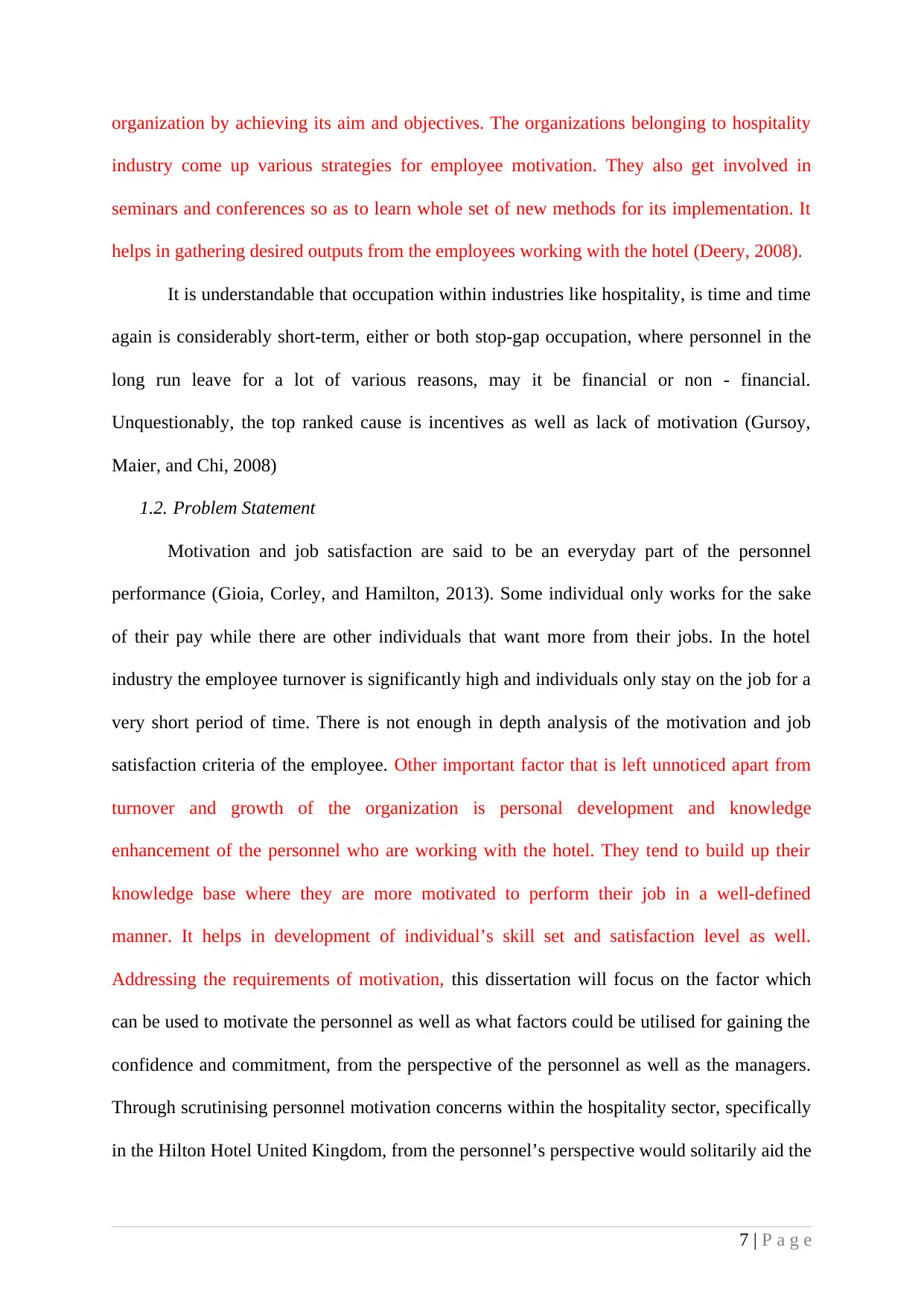
organization by achieving its aim and objectives. The organizations belonging to hospitality
industry come up various strategies for employee motivation. They also get involved in
seminars and conferences so as to learn whole set of new methods for its implementation. It
helps in gathering desired outputs from the employees working with the hotel (Deery, 2008).
It is understandable that occupation within industries like hospitality, is time and time
again is considerably short-term, either or both stop-gap occupation, where personnel in the
long run leave for a lot of various reasons, may it be financial or non - financial.
Unquestionably, the top ranked cause is incentives as well as lack of motivation (Gursoy,
Maier, and Chi, 2008)
1.2. Problem Statement
Motivation and job satisfaction are said to be an everyday part of the personnel
performance (Gioia, Corley, and Hamilton, 2013). Some individual only works for the sake
of their pay while there are other individuals that want more from their jobs. In the hotel
industry the employee turnover is significantly high and individuals only stay on the job for a
very short period of time. There is not enough in depth analysis of the motivation and job
satisfaction criteria of the employee. Other important factor that is left unnoticed apart from
turnover and growth of the organization is personal development and knowledge
enhancement of the personnel who are working with the hotel. They tend to build up their
knowledge base where they are more motivated to perform their job in a well-defined
manner. It helps in development of individual’s skill set and satisfaction level as well.
Addressing the requirements of motivation, this dissertation will focus on the factor which
can be used to motivate the personnel as well as what factors could be utilised for gaining the
confidence and commitment, from the perspective of the personnel as well as the managers.
Through scrutinising personnel motivation concerns within the hospitality sector, specifically
in the Hilton Hotel United Kingdom, from the personnel’s perspective would solitarily aid the
7 | P a g e
industry come up various strategies for employee motivation. They also get involved in
seminars and conferences so as to learn whole set of new methods for its implementation. It
helps in gathering desired outputs from the employees working with the hotel (Deery, 2008).
It is understandable that occupation within industries like hospitality, is time and time
again is considerably short-term, either or both stop-gap occupation, where personnel in the
long run leave for a lot of various reasons, may it be financial or non - financial.
Unquestionably, the top ranked cause is incentives as well as lack of motivation (Gursoy,
Maier, and Chi, 2008)
1.2. Problem Statement
Motivation and job satisfaction are said to be an everyday part of the personnel
performance (Gioia, Corley, and Hamilton, 2013). Some individual only works for the sake
of their pay while there are other individuals that want more from their jobs. In the hotel
industry the employee turnover is significantly high and individuals only stay on the job for a
very short period of time. There is not enough in depth analysis of the motivation and job
satisfaction criteria of the employee. Other important factor that is left unnoticed apart from
turnover and growth of the organization is personal development and knowledge
enhancement of the personnel who are working with the hotel. They tend to build up their
knowledge base where they are more motivated to perform their job in a well-defined
manner. It helps in development of individual’s skill set and satisfaction level as well.
Addressing the requirements of motivation, this dissertation will focus on the factor which
can be used to motivate the personnel as well as what factors could be utilised for gaining the
confidence and commitment, from the perspective of the personnel as well as the managers.
Through scrutinising personnel motivation concerns within the hospitality sector, specifically
in the Hilton Hotel United Kingdom, from the personnel’s perspective would solitarily aid the
7 | P a g e
Paraphrase This Document
Need a fresh take? Get an instant paraphrase of this document with our AI Paraphraser
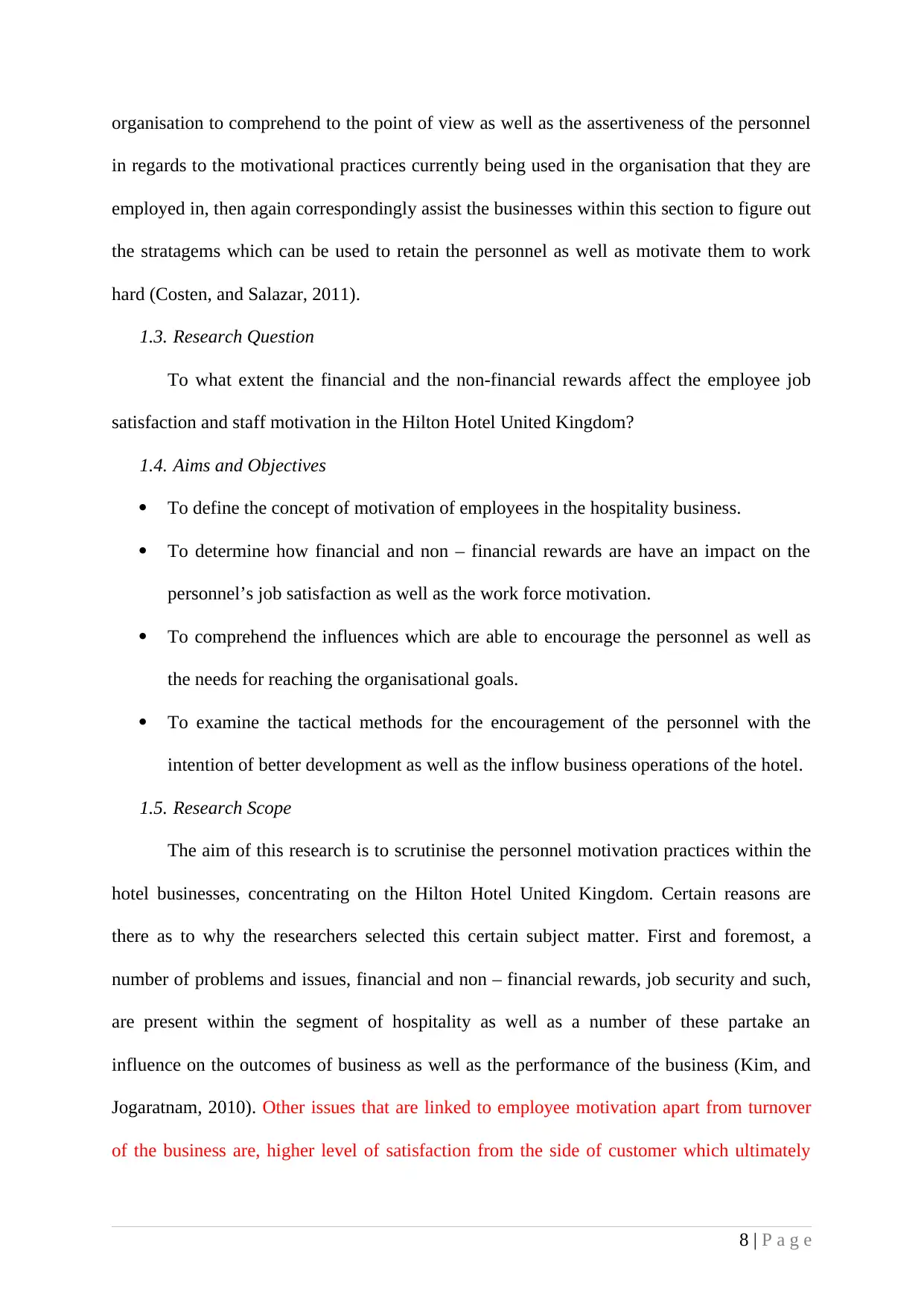
organisation to comprehend to the point of view as well as the assertiveness of the personnel
in regards to the motivational practices currently being used in the organisation that they are
employed in, then again correspondingly assist the businesses within this section to figure out
the stratagems which can be used to retain the personnel as well as motivate them to work
hard (Costen, and Salazar, 2011).
1.3. Research Question
To what extent the financial and the non-financial rewards affect the employee job
satisfaction and staff motivation in the Hilton Hotel United Kingdom?
1.4. Aims and Objectives
To define the concept of motivation of employees in the hospitality business.
To determine how financial and non – financial rewards are have an impact on the
personnel’s job satisfaction as well as the work force motivation.
To comprehend the influences which are able to encourage the personnel as well as
the needs for reaching the organisational goals.
To examine the tactical methods for the encouragement of the personnel with the
intention of better development as well as the inflow business operations of the hotel.
1.5. Research Scope
The aim of this research is to scrutinise the personnel motivation practices within the
hotel businesses, concentrating on the Hilton Hotel United Kingdom. Certain reasons are
there as to why the researchers selected this certain subject matter. First and foremost, a
number of problems and issues, financial and non – financial rewards, job security and such,
are present within the segment of hospitality as well as a number of these partake an
influence on the outcomes of business as well as the performance of the business (Kim, and
Jogaratnam, 2010). Other issues that are linked to employee motivation apart from turnover
of the business are, higher level of satisfaction from the side of customer which ultimately
8 | P a g e
in regards to the motivational practices currently being used in the organisation that they are
employed in, then again correspondingly assist the businesses within this section to figure out
the stratagems which can be used to retain the personnel as well as motivate them to work
hard (Costen, and Salazar, 2011).
1.3. Research Question
To what extent the financial and the non-financial rewards affect the employee job
satisfaction and staff motivation in the Hilton Hotel United Kingdom?
1.4. Aims and Objectives
To define the concept of motivation of employees in the hospitality business.
To determine how financial and non – financial rewards are have an impact on the
personnel’s job satisfaction as well as the work force motivation.
To comprehend the influences which are able to encourage the personnel as well as
the needs for reaching the organisational goals.
To examine the tactical methods for the encouragement of the personnel with the
intention of better development as well as the inflow business operations of the hotel.
1.5. Research Scope
The aim of this research is to scrutinise the personnel motivation practices within the
hotel businesses, concentrating on the Hilton Hotel United Kingdom. Certain reasons are
there as to why the researchers selected this certain subject matter. First and foremost, a
number of problems and issues, financial and non – financial rewards, job security and such,
are present within the segment of hospitality as well as a number of these partake an
influence on the outcomes of business as well as the performance of the business (Kim, and
Jogaratnam, 2010). Other issues that are linked to employee motivation apart from turnover
of the business are, higher level of satisfaction from the side of customer which ultimately
8 | P a g e
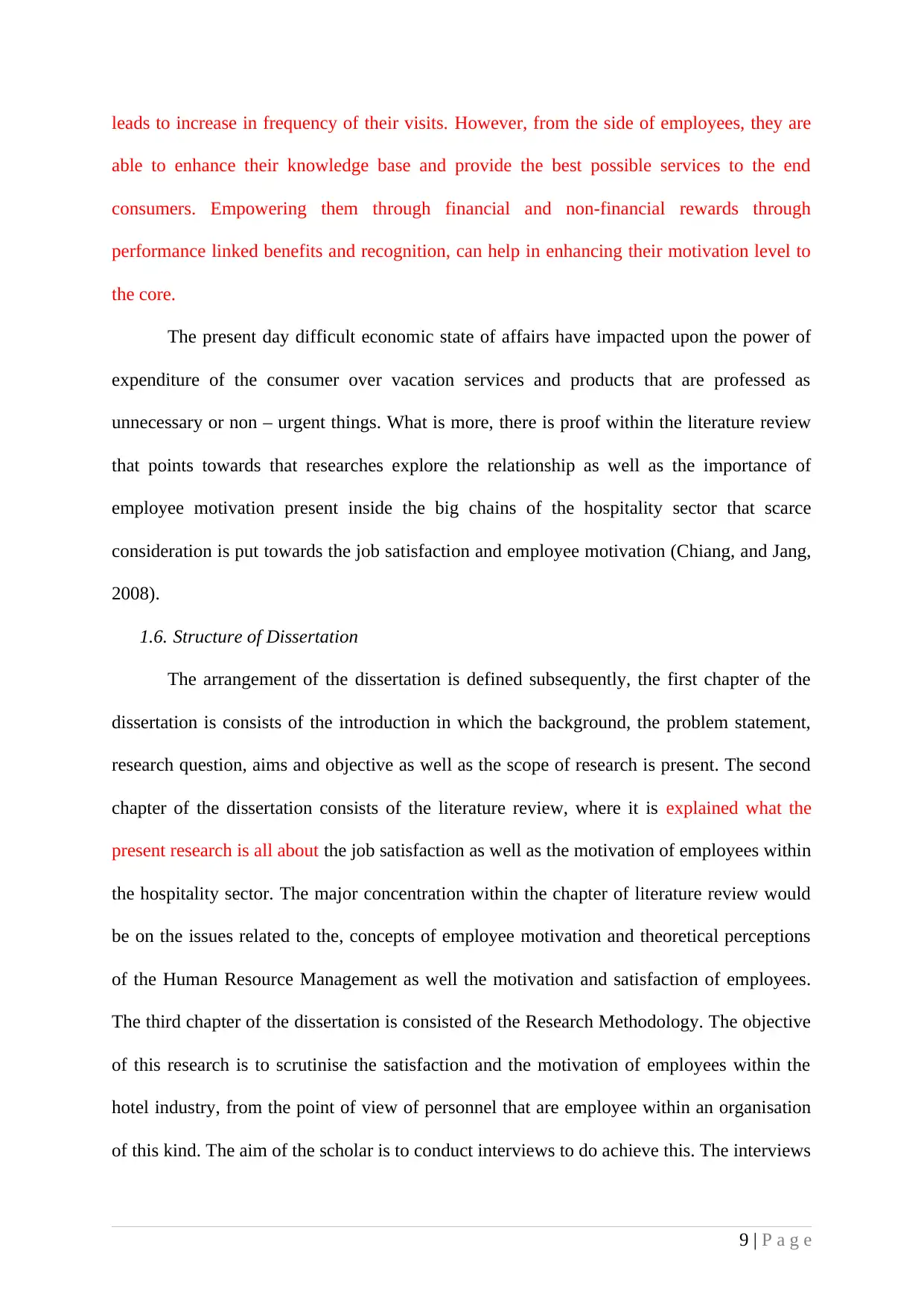
leads to increase in frequency of their visits. However, from the side of employees, they are
able to enhance their knowledge base and provide the best possible services to the end
consumers. Empowering them through financial and non-financial rewards through
performance linked benefits and recognition, can help in enhancing their motivation level to
the core.
The present day difficult economic state of affairs have impacted upon the power of
expenditure of the consumer over vacation services and products that are professed as
unnecessary or non – urgent things. What is more, there is proof within the literature review
that points towards that researches explore the relationship as well as the importance of
employee motivation present inside the big chains of the hospitality sector that scarce
consideration is put towards the job satisfaction and employee motivation (Chiang, and Jang,
2008).
1.6. Structure of Dissertation
The arrangement of the dissertation is defined subsequently, the first chapter of the
dissertation is consists of the introduction in which the background, the problem statement,
research question, aims and objective as well as the scope of research is present. The second
chapter of the dissertation consists of the literature review, where it is explained what the
present research is all about the job satisfaction as well as the motivation of employees within
the hospitality sector. The major concentration within the chapter of literature review would
be on the issues related to the, concepts of employee motivation and theoretical perceptions
of the Human Resource Management as well the motivation and satisfaction of employees.
The third chapter of the dissertation is consisted of the Research Methodology. The objective
of this research is to scrutinise the satisfaction and the motivation of employees within the
hotel industry, from the point of view of personnel that are employee within an organisation
of this kind. The aim of the scholar is to conduct interviews to do achieve this. The interviews
9 | P a g e
able to enhance their knowledge base and provide the best possible services to the end
consumers. Empowering them through financial and non-financial rewards through
performance linked benefits and recognition, can help in enhancing their motivation level to
the core.
The present day difficult economic state of affairs have impacted upon the power of
expenditure of the consumer over vacation services and products that are professed as
unnecessary or non – urgent things. What is more, there is proof within the literature review
that points towards that researches explore the relationship as well as the importance of
employee motivation present inside the big chains of the hospitality sector that scarce
consideration is put towards the job satisfaction and employee motivation (Chiang, and Jang,
2008).
1.6. Structure of Dissertation
The arrangement of the dissertation is defined subsequently, the first chapter of the
dissertation is consists of the introduction in which the background, the problem statement,
research question, aims and objective as well as the scope of research is present. The second
chapter of the dissertation consists of the literature review, where it is explained what the
present research is all about the job satisfaction as well as the motivation of employees within
the hospitality sector. The major concentration within the chapter of literature review would
be on the issues related to the, concepts of employee motivation and theoretical perceptions
of the Human Resource Management as well the motivation and satisfaction of employees.
The third chapter of the dissertation is consisted of the Research Methodology. The objective
of this research is to scrutinise the satisfaction and the motivation of employees within the
hotel industry, from the point of view of personnel that are employee within an organisation
of this kind. The aim of the scholar is to conduct interviews to do achieve this. The interviews
9 | P a g e
⊘ This is a preview!⊘
Do you want full access?
Subscribe today to unlock all pages.

Trusted by 1+ million students worldwide
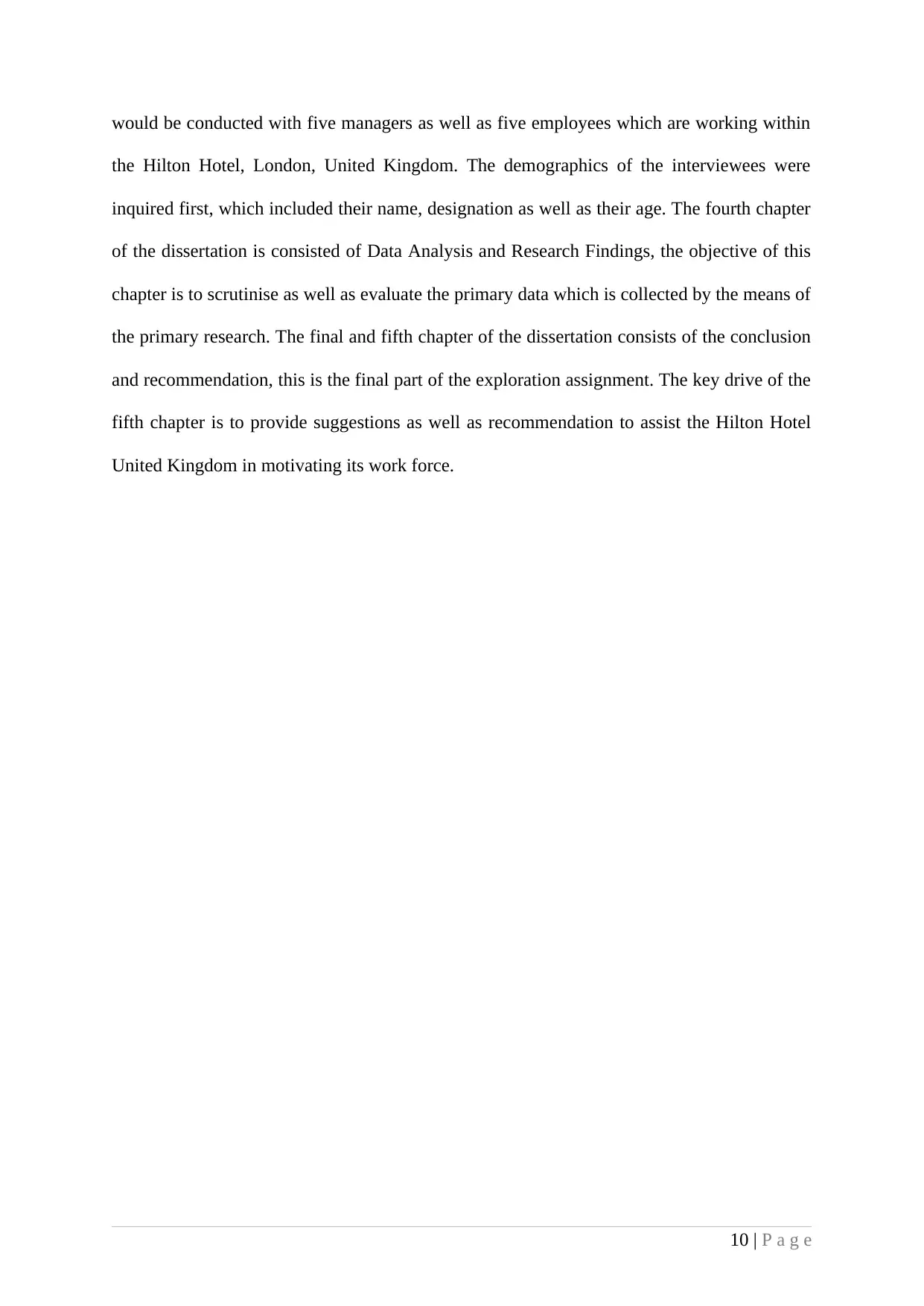
would be conducted with five managers as well as five employees which are working within
the Hilton Hotel, London, United Kingdom. The demographics of the interviewees were
inquired first, which included their name, designation as well as their age. The fourth chapter
of the dissertation is consisted of Data Analysis and Research Findings, the objective of this
chapter is to scrutinise as well as evaluate the primary data which is collected by the means of
the primary research. The final and fifth chapter of the dissertation consists of the conclusion
and recommendation, this is the final part of the exploration assignment. The key drive of the
fifth chapter is to provide suggestions as well as recommendation to assist the Hilton Hotel
United Kingdom in motivating its work force.
10 | P a g e
the Hilton Hotel, London, United Kingdom. The demographics of the interviewees were
inquired first, which included their name, designation as well as their age. The fourth chapter
of the dissertation is consisted of Data Analysis and Research Findings, the objective of this
chapter is to scrutinise as well as evaluate the primary data which is collected by the means of
the primary research. The final and fifth chapter of the dissertation consists of the conclusion
and recommendation, this is the final part of the exploration assignment. The key drive of the
fifth chapter is to provide suggestions as well as recommendation to assist the Hilton Hotel
United Kingdom in motivating its work force.
10 | P a g e
Paraphrase This Document
Need a fresh take? Get an instant paraphrase of this document with our AI Paraphraser
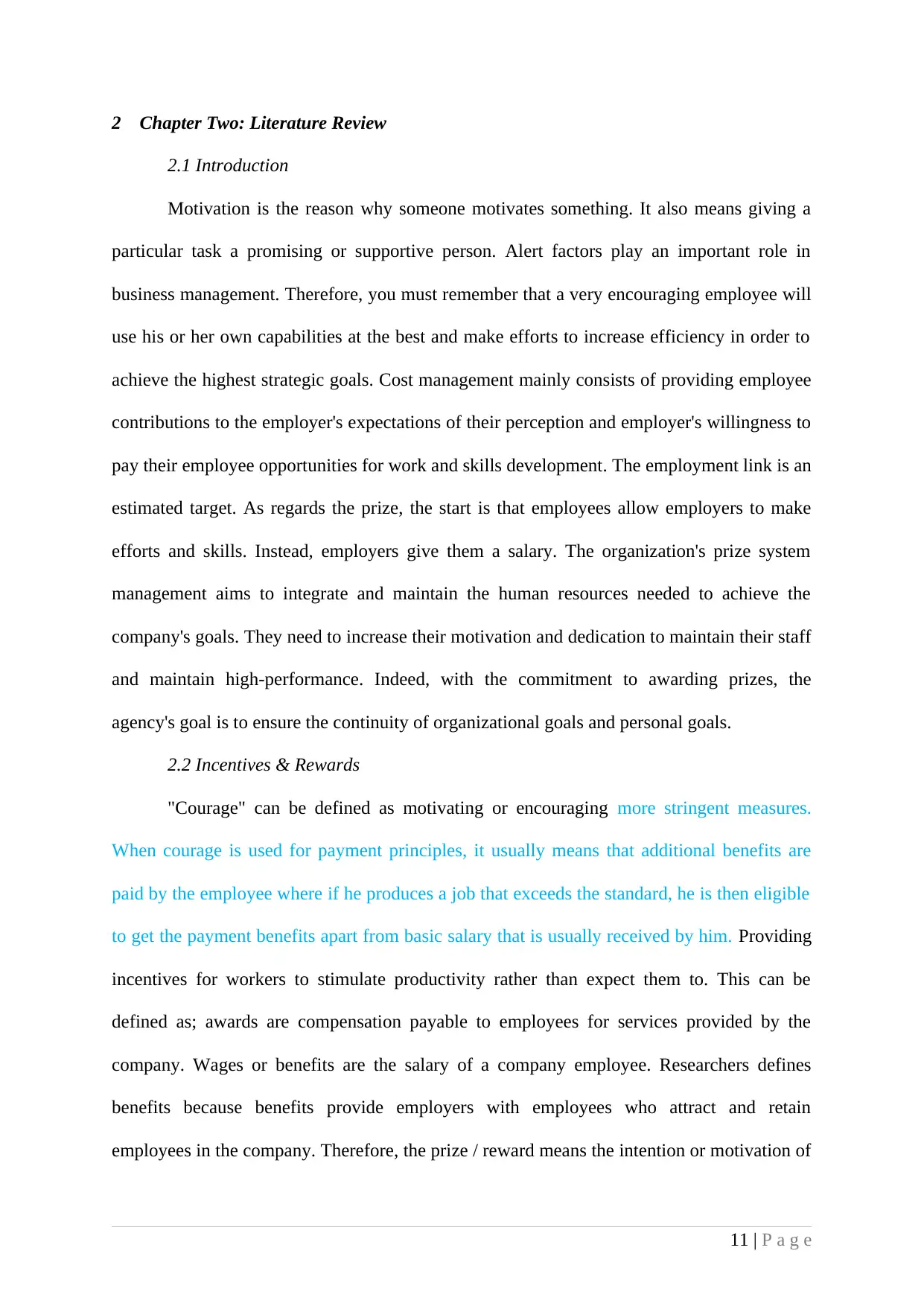
2 Chapter Two: Literature Review
2.1 Introduction
Motivation is the reason why someone motivates something. It also means giving a
particular task a promising or supportive person. Alert factors play an important role in
business management. Therefore, you must remember that a very encouraging employee will
use his or her own capabilities at the best and make efforts to increase efficiency in order to
achieve the highest strategic goals. Cost management mainly consists of providing employee
contributions to the employer's expectations of their perception and employer's willingness to
pay their employee opportunities for work and skills development. The employment link is an
estimated target. As regards the prize, the start is that employees allow employers to make
efforts and skills. Instead, employers give them a salary. The organization's prize system
management aims to integrate and maintain the human resources needed to achieve the
company's goals. They need to increase their motivation and dedication to maintain their staff
and maintain high-performance. Indeed, with the commitment to awarding prizes, the
agency's goal is to ensure the continuity of organizational goals and personal goals.
2.2 Incentives & Rewards
"Courage" can be defined as motivating or encouraging more stringent measures.
When courage is used for payment principles, it usually means that additional benefits are
paid by the employee where if he produces a job that exceeds the standard, he is then eligible
to get the payment benefits apart from basic salary that is usually received by him. Providing
incentives for workers to stimulate productivity rather than expect them to. This can be
defined as; awards are compensation payable to employees for services provided by the
company. Wages or benefits are the salary of a company employee. Researchers defines
benefits because benefits provide employers with employees who attract and retain
employees in the company. Therefore, the prize / reward means the intention or motivation of
11 | P a g e
2.1 Introduction
Motivation is the reason why someone motivates something. It also means giving a
particular task a promising or supportive person. Alert factors play an important role in
business management. Therefore, you must remember that a very encouraging employee will
use his or her own capabilities at the best and make efforts to increase efficiency in order to
achieve the highest strategic goals. Cost management mainly consists of providing employee
contributions to the employer's expectations of their perception and employer's willingness to
pay their employee opportunities for work and skills development. The employment link is an
estimated target. As regards the prize, the start is that employees allow employers to make
efforts and skills. Instead, employers give them a salary. The organization's prize system
management aims to integrate and maintain the human resources needed to achieve the
company's goals. They need to increase their motivation and dedication to maintain their staff
and maintain high-performance. Indeed, with the commitment to awarding prizes, the
agency's goal is to ensure the continuity of organizational goals and personal goals.
2.2 Incentives & Rewards
"Courage" can be defined as motivating or encouraging more stringent measures.
When courage is used for payment principles, it usually means that additional benefits are
paid by the employee where if he produces a job that exceeds the standard, he is then eligible
to get the payment benefits apart from basic salary that is usually received by him. Providing
incentives for workers to stimulate productivity rather than expect them to. This can be
defined as; awards are compensation payable to employees for services provided by the
company. Wages or benefits are the salary of a company employee. Researchers defines
benefits because benefits provide employers with employees who attract and retain
employees in the company. Therefore, the prize / reward means the intention or motivation of
11 | P a g e
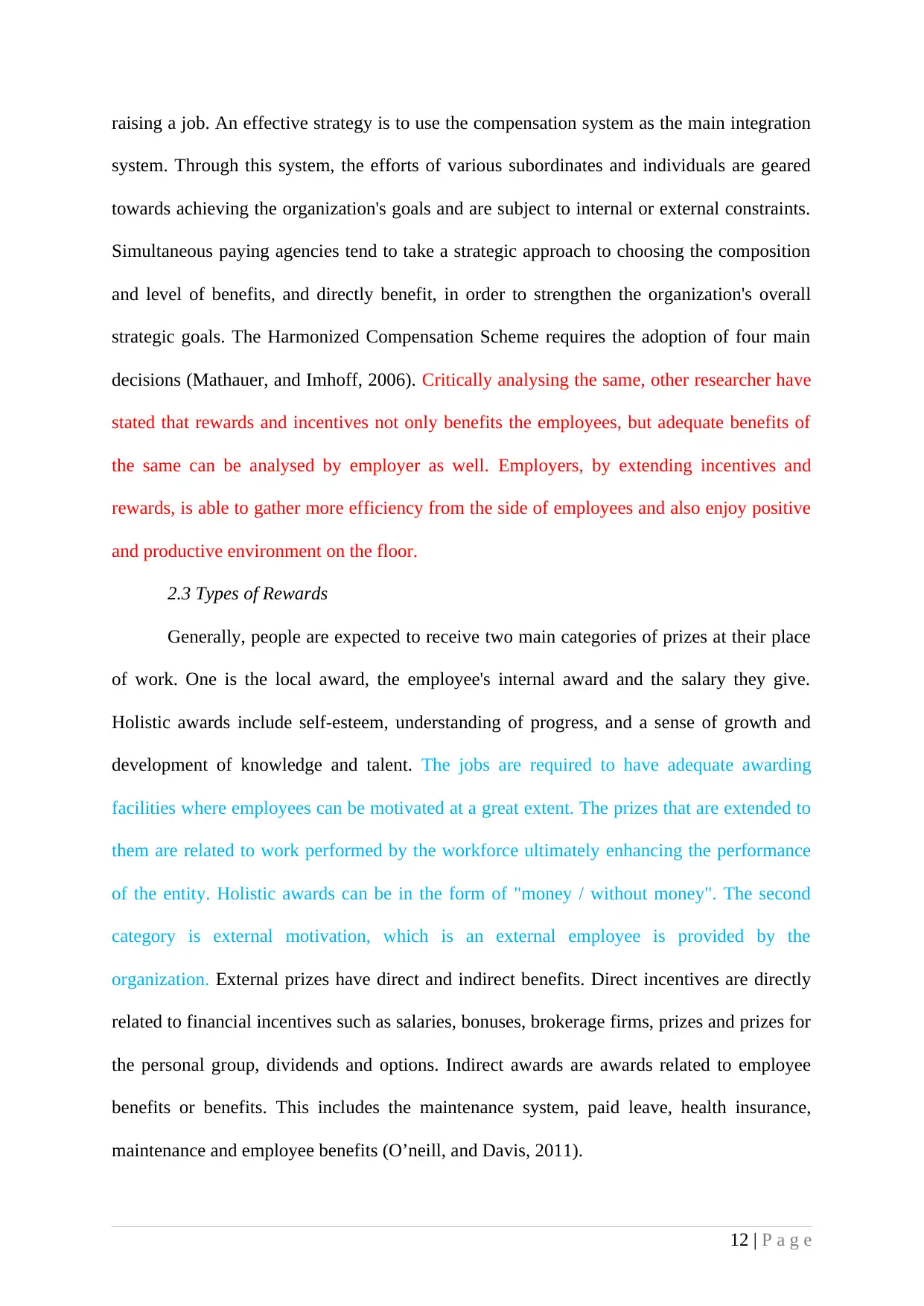
raising a job. An effective strategy is to use the compensation system as the main integration
system. Through this system, the efforts of various subordinates and individuals are geared
towards achieving the organization's goals and are subject to internal or external constraints.
Simultaneous paying agencies tend to take a strategic approach to choosing the composition
and level of benefits, and directly benefit, in order to strengthen the organization's overall
strategic goals. The Harmonized Compensation Scheme requires the adoption of four main
decisions (Mathauer, and Imhoff, 2006). Critically analysing the same, other researcher have
stated that rewards and incentives not only benefits the employees, but adequate benefits of
the same can be analysed by employer as well. Employers, by extending incentives and
rewards, is able to gather more efficiency from the side of employees and also enjoy positive
and productive environment on the floor.
2.3 Types of Rewards
Generally, people are expected to receive two main categories of prizes at their place
of work. One is the local award, the employee's internal award and the salary they give.
Holistic awards include self-esteem, understanding of progress, and a sense of growth and
development of knowledge and talent. The jobs are required to have adequate awarding
facilities where employees can be motivated at a great extent. The prizes that are extended to
them are related to work performed by the workforce ultimately enhancing the performance
of the entity. Holistic awards can be in the form of "money / without money". The second
category is external motivation, which is an external employee is provided by the
organization. External prizes have direct and indirect benefits. Direct incentives are directly
related to financial incentives such as salaries, bonuses, brokerage firms, prizes and prizes for
the personal group, dividends and options. Indirect awards are awards related to employee
benefits or benefits. This includes the maintenance system, paid leave, health insurance,
maintenance and employee benefits (O’neill, and Davis, 2011).
12 | P a g e
system. Through this system, the efforts of various subordinates and individuals are geared
towards achieving the organization's goals and are subject to internal or external constraints.
Simultaneous paying agencies tend to take a strategic approach to choosing the composition
and level of benefits, and directly benefit, in order to strengthen the organization's overall
strategic goals. The Harmonized Compensation Scheme requires the adoption of four main
decisions (Mathauer, and Imhoff, 2006). Critically analysing the same, other researcher have
stated that rewards and incentives not only benefits the employees, but adequate benefits of
the same can be analysed by employer as well. Employers, by extending incentives and
rewards, is able to gather more efficiency from the side of employees and also enjoy positive
and productive environment on the floor.
2.3 Types of Rewards
Generally, people are expected to receive two main categories of prizes at their place
of work. One is the local award, the employee's internal award and the salary they give.
Holistic awards include self-esteem, understanding of progress, and a sense of growth and
development of knowledge and talent. The jobs are required to have adequate awarding
facilities where employees can be motivated at a great extent. The prizes that are extended to
them are related to work performed by the workforce ultimately enhancing the performance
of the entity. Holistic awards can be in the form of "money / without money". The second
category is external motivation, which is an external employee is provided by the
organization. External prizes have direct and indirect benefits. Direct incentives are directly
related to financial incentives such as salaries, bonuses, brokerage firms, prizes and prizes for
the personal group, dividends and options. Indirect awards are awards related to employee
benefits or benefits. This includes the maintenance system, paid leave, health insurance,
maintenance and employee benefits (O’neill, and Davis, 2011).
12 | P a g e
⊘ This is a preview!⊘
Do you want full access?
Subscribe today to unlock all pages.

Trusted by 1+ million students worldwide
1 out of 50
Related Documents
Your All-in-One AI-Powered Toolkit for Academic Success.
+13062052269
info@desklib.com
Available 24*7 on WhatsApp / Email
![[object Object]](/_next/static/media/star-bottom.7253800d.svg)
Unlock your academic potential
Copyright © 2020–2025 A2Z Services. All Rights Reserved. Developed and managed by ZUCOL.





